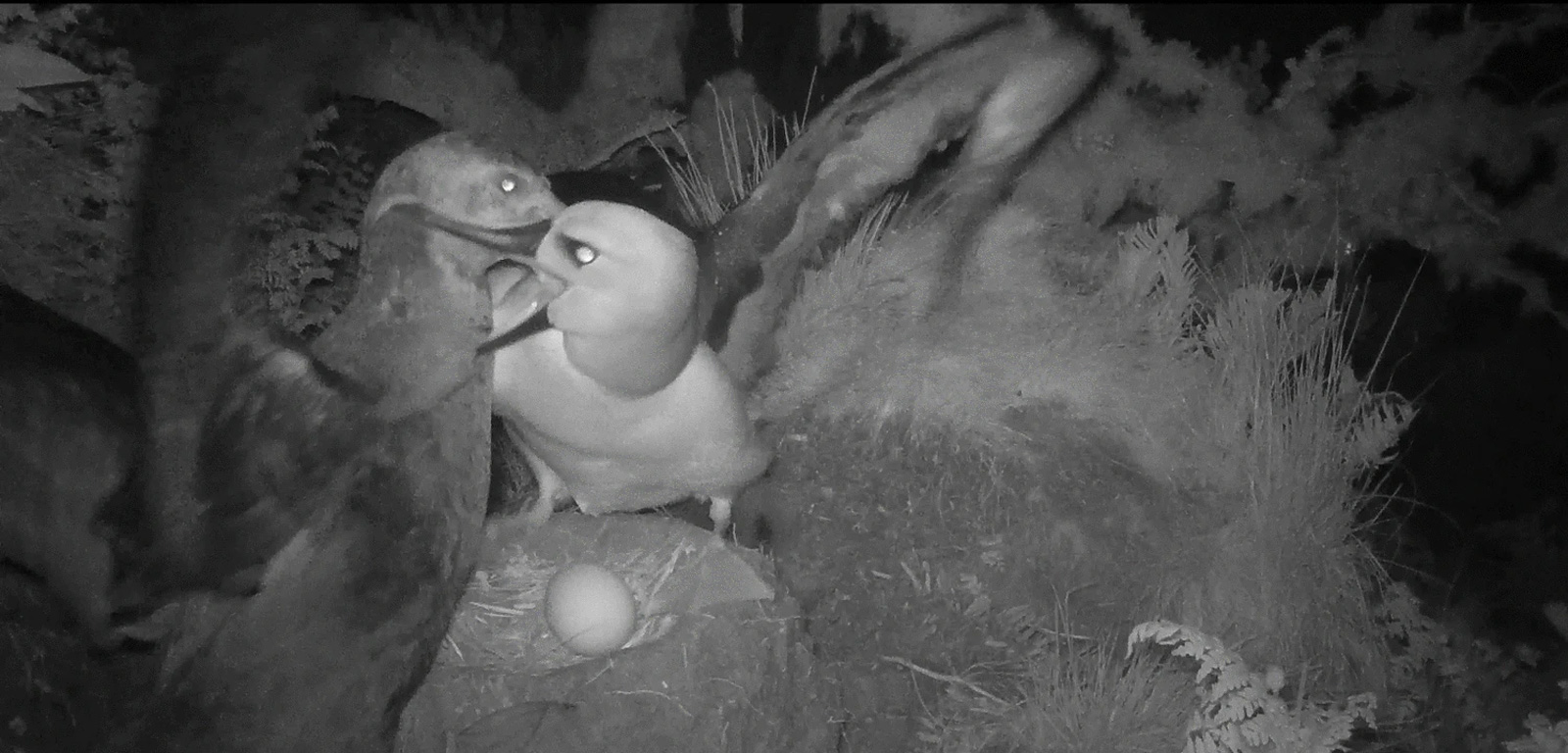Clash of the Feathered Titans
For Gough Island’s imperiled albatrosses, the sudden emergence of a giant new predator is tough to handle.
Article body copy
In the middle of the night, an albatross rests on its single, precious egg. But the great bird is disturbed by the approach of webbed feet padding in the darkness. The albatross stands to defend its egg, bill snapping. Its foe, a burly male southern giant petrel, isn’t there for the egg. With a lunge, the petrel bites the albatross around the neck, dragging it off into the bushes.
The albatross never returns to its egg.
This feathered violence is new to science. On Gough Island—a lonely rock in the middle of the South Atlantic—researchers have recently discovered southern giant petrels, which usually feed on fish, krill, and young birds, hunting and killing massive adult albatrosses.
Gough Island is one of the few breeding sites of the Atlantic yellow-nosed albatross, an endangered species that has been under the careful watch of rotating sets of researchers since 2008. The first evidence of the attacks emerged in October 2017, when researchers found the carcasses of 19 adult albatrosses.
At first, they thought the deaths might have been a freak accident; that the albatrosses had crash-landed during a windstorm, says Michelle Risi, a wildlife ecologist with the Royal Society for the Protection of Birds in the United Kingdom. But when she and her colleagues had their turn on the island in 2018, it became clear that the deaths were no fluke.
“We returned to the area several times to assess the number of adult carcasses and were completely shocked to be finding several new ones each week,” recounts Risi.
The team wondered if the deaths were the result of Gough Island’s ravenous invasive mice, which have been fatally harassing the island’s albatrosses. To get to the bottom of this mystery, the team returned in 2019 and set up 16 motion-activated cameras near albatross nests. Nearly one million images and more than 419 hours of footage revealed the culprit as male southern giant petrels, which also breed on Gough Island. The team’s findings, published in a recent study, include graphic footage of 11 different petrel attacks, five of which end in an albatross’s death.
Watching the southern giant petrels attack albatrosses in the night was shocking, says Risi. But at the same time, such a bold predatory maneuver isn’t exactly out of character.
A graphic camera trap video shows the unexpected attack of a southern giant petrel on an Atlantic yellow-nosed albatross on Gough Island in the South Atlantic. Video courtesy of Michelle Risi, Christopher Jones, and Alexis Osborne
Southern giant petrels are adept and eager scavengers that dominate and messily devour seaside carcasses. But they are also competent predators. The birds are gull-shaped but goose-sized, and cast an intimidating shadow on the Southern Ocean food web. Shrewd opportunists, they prey on young or sick penguins and seals, and the chicks of many bird species. Giant petrels have even been seen tearing at the flesh of surfacing sperm whales.
“That is the nature of giant petrels,” says Tegan Carpenter-Kling, an ecologist with BirdLife South Africa in Johannesburg, who is not involved with this study. “They are predatory birds—quite smart and ruthless.”
Still, the Gough Island team’s recordings were a surprise to Carpenter-Kling. “I was shocked. I have never heard of giant petrels going for adult birds unless they are injured.”
Richard Phillips, a seabird ecologist with the British Antarctic Survey who wasn’t involved in the study, points out that attacking healthy adult albatrosses can have immediate and costly drawbacks. “You’re way better off killing something that’s much more defenseless,” he says. “There’s a risk [the giant petrels] will get pecked in the eye or injured.”
It’s not yet clear why the southern giant petrels on Gough Island are taking such risks. Theoretically, it could be because they’re suffering a dearth of ocean-based food. But Risi thinks there should be enough seals and penguins around the island to sustain the breeding petrels.
It’s also possible the southern giant petrels picked up the habit through exploiting albatrosses already weakened by the constant aggravation from the island’s invasive mice.
Whatever the cause, the behavior appears to be a recent development limited to Gough Island. Phillips notes that if southern giant petrels were killing albatrosses elsewhere, there’d be records of corpses at some of the other seabird monitoring sites in the Southern Ocean. It’s difficult to ignore dead albatrosses, given the bird’s vulnerability to introduced predators.
“You would start thinking, Was it a cat? Was it rats? You would almost panic, in a way,” says Phillips.
The albatross killings do have some disconcerting implications for Gough Island’s Atlantic yellow-nosed albatrosses, though.
“If this behavior spreads and it becomes more common among the giant petrels, it could definitely pose a threat to the albatross population,” says Carpenter-Kling, adding that the death rate of adults is a major factor dictating a population’s trajectory.
Phillips reckons that if the few hundred southern giant petrel pairs breeding on Gough Island became consistent albatross slayers “they probably would eat an albatross every few days.”
Predation by southern giant petrels isn’t the only challenge faced by Gough Island’s albatrosses. In addition to mice, the seabirds are threatened by plastic pollution, climate change, and fatal interactions with fishing vessels. We “need to get the anthropogenic issues resolved,” Risi says, “so that predation by giant petrels does not become an additive problem.”

